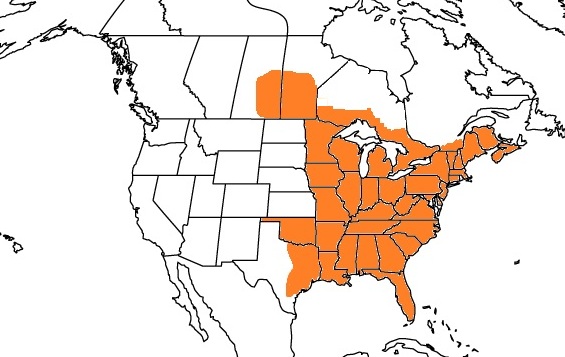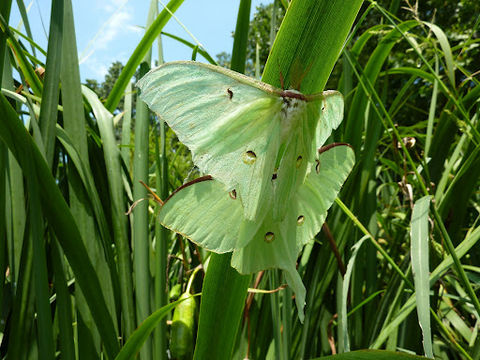Habitat
Geographical
Location:
Actias luna can be found in deciduous hardwood forests in both
the United States and Canada. In the United States population
locations range from east
 of
North Dakota all the way south to central Florida and parts of
Texas. In Canada there has been evidence of sightings from Nova
Scotia west to Saskatchewan and Quebec (Butterflies and moths of
north America). The luna moth is a strictly
terrestrial organism, meaning it spends its life on land. Deciduous hardwood forests lose their leaves in
the winter, which explains why we do not see luna moths between
the months of November and January. Sighting this moth is a lot
more difficult that you may think!
of
North Dakota all the way south to central Florida and parts of
Texas. In Canada there has been evidence of sightings from Nova
Scotia west to Saskatchewan and Quebec (Butterflies and moths of
north America). The luna moth is a strictly
terrestrial organism, meaning it spends its life on land. Deciduous hardwood forests lose their leaves in
the winter, which explains why we do not see luna moths between
the months of November and January. Sighting this moth is a lot
more difficult that you may think!
Another reason why the luna moth concentrates its populations in deciduous forests is because of all the oxygen naturally produced by these plants. Actias luna larva, just like most other moth larva, depend especially on this aerobic characteristic. In general, moth larvae can survive short term in anaerobic conditions, but not anaerobic and high temperature conditions combined, and some of these populations live in southern North America, where it can get hot. According to Hansen and Heidt in a journal published in 2006, a scientific study was performed on coddling moths and their survival rates under heated, anaerobic conditions. "At 22ºC Lepidoptera larvae can survive in anaerobic conditions (under water, nitrogen, vaccuum) for approximately thirty minutes, but at 50ºC most of the larvae died within five minutes" (Hansen & Heidt, 2006). Insect respiration rates increase when temperature rates increase, and this study shows that effective respiration is tough when there is an insufficient amount of oxygen.
Where can I see one??
Adult Actias luna are mostly active only in the late hours of the night, and blend in incredibly well with their surroundings during the day, making this organism especially difficult to spot. One of the most common methods of sighting the luna moth is by using very bright lights at night time. Male luna moths are especially attracted to these lights, but this moth-human interaction can be detrimental. It can distract the males from their adult quests to reproduce with a waiting female (eol.com). The luna moth caterpillar does not follow the same nocturnal lifestyle as the adults. It is actively munching on tree foliage, its main diet, throughout the day and is much less active at night. However, the caterpillars do follow the adults when it comes to using their bright green color to camouflage into their leafy surroundings, making them also very difficult to spot.
To link back to the luna moth Homepage, click
here.
To learn more about the luna moth diet, click
here.
To learn more about the taxonomic classification of the luna
moth, click here.
To view the gallery, click here.
